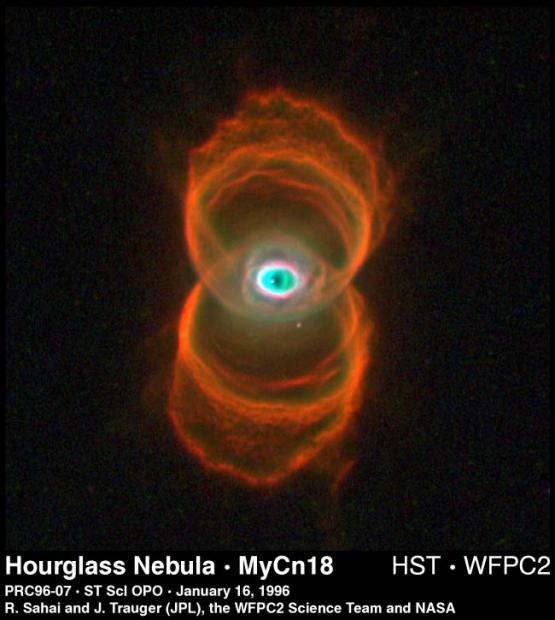Reiseberichte, Fotos, Bilder, Reiseinformation, Reisetipps weltweit. Schreiben Sie Ihren Reisebericht. Zeigen Sie Fotos und Bilder online. Reiseerfahrung mit anderen teilen! |  bisher 167 mal gesehen bisher 167 mal gesehen | | ZurĂĽck zum Bericht | alle Bilder dieser Serie | alle Bilder dieses Autors |  Foto Foto | Foto 5 von 6 | Foto  |  | Reisen in die Zukunft...
Irgendwo im Universum, 8000 Lichtjahre entfernt.
This is an image of MyCn18, a young planetary nebula located about 8,000 light-years away, taken with the Wide Field and Planetary Camera 2 (WFPC2) aboard NASA's Hubble Space Telescope (HST). This Hubble image reveals the true shape of MyCn18 to be an hourglass with an intricate pattern of "etchings" in its walls. This picture has been composed from three separate images taken in the light of ionized nitrogen (represented by red), hydrogen (green), and doubly-ionized oxygen (blue). The results are of great interest because they shed new light on the poorly understood ejection of stellar matter which accompanies the slow death of Sun-like stars. In previous ground-based images, MyCn18 appears to be a pair of large outer rings with a smaller central one, but the fine details cannot be seen.
According to one theory for the formation of planetary nebulae, the hourglass shape is produced by the expansion of a fast stellar wind within a slowly expanding cloud which is more dense near its equator than near its poles. What appears as a bright elliptical ring in the center, and at first sight might be mistaken for an equatorially dense region, is seen on closer inspection to be a potato shaped structure with a symmetry axis dramatically different from that of the larger hourglass. The hot star which has been thought to eject and illuminate the nebula, and therefore expected to lie at its center of symmetry, is clearly off center. Hence MyCn18, as revealed by Hubble, does not fulfill some crucial theoretical expectations.
Hubble has also revealed other features in MyCn18 which are completely new and unexpected. For example, there is a pair of intersecting elliptical rings in the central region which appear to be the rims of a smaller hourglass. There are the intricate patterns of the etchings on the hourglass walls. The arc-like etchings could be the remnants of discrete shells ejected from the star when it was younger (e.g. as seen in the Egg Nebula), flow instabilities, or could result from the action of a narrow beam of matter impinging on the hourglass walls. An unseen companion star and accompanying gravitational effects may well be necessary in order to explain the structure of MyCn18.
BACKGROUND: PLANETARY NEBULAE
When Sun-like stars get old, they become cooler and redder, increasing their sizes and energy output tremendously: they are called red giants. Most of the carbon (the basis of life) and particulate matter (crucial building blocks of solar systems like ours) in the universe is manufactured and dispersed by red giant stars. When the red giant star has ejected all of its outer layers, the ultraviolet radiation from the exposed hot stellar core makes the surrounding cloud of matter created during the red giant phase glow: the object becomes a planetary nebula. A long-standing puzzle is how planetary nebulae acquire their complex shapes and symmetries, since red giants and the gas/dust clouds surrounding them are mostly round. Hubble's ability to see very fine structural details (usually blurred beyond recognition in ground-based images) enables us to look for clues to this puzzle.
Credits: Raghvendra Sahai and John Trauger (JPL), the WFPC2 science team, and NASA
|
|

| | Aktueller Bericht: Erstes 3 dimensionales Panorama Foto vom Mars - ... | | Autor des Berichts: Ben Berger | | erstellt: 06.01.2004 | | bisher gesehen: 167 mal | | Stichworte: Mars, Planeten, Sonnensystem, Raumfahrt |
|
|
|
|
|